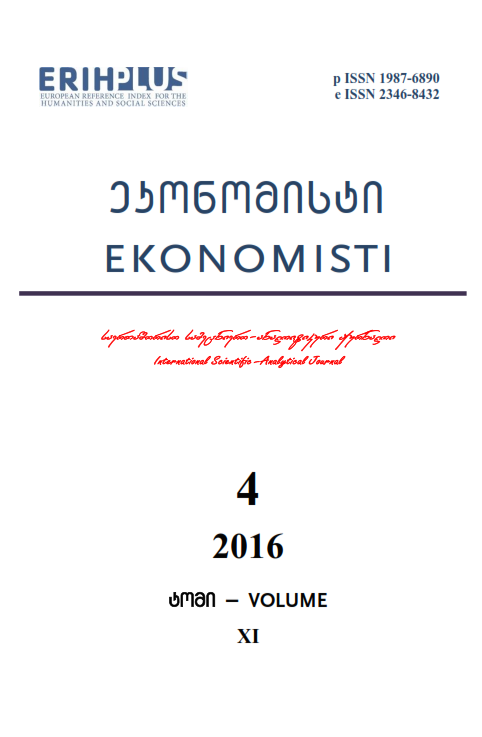
The international scientific and analytical, reviewed, printing and electronic journal of Paata Gugushvili Institute of Economics of Ivane Javakhishvili Tbilisi State University

Demand for Healthcare Services and Opportunities for Enhancing the Efficiency of Medical Institutions: A Case Study of Georgia
DOI: 10.36172/EKONOMISTI.2024.XX.03.SHARASHENIDZE
Expanded Summary
This article presents an extensive analysis of Georgia’s healthcare system, with particular emphasis on hospital capacity standards, healthcare delivery, and the associated challenges faced by both public and private healthcare sectors. The research delves into multiple factors that influence healthcare delivery, including population distribution, urban-rural healthcare disparities, the aging demographic, healthcare infrastructure, and the accessibility and availability of medical professionals across the country. These elements are critical in shaping the overall efficiency, equity, and sustainability of Georgia’s healthcare system.
In recent years, Georgia has undergone substantial demographic changes, with a significant increase in its elderly population. This shift, coupled with ongoing healthcare reforms and population growth, has put pressure on the healthcare system to adapt to emerging needs. Specifically, there has been a rising demand for comprehensive healthcare services, ranging from preventive care to long-term management of chronic diseases. This demand is further compounded by a wide geographic distribution of healthcare services, which has created disparities in access to care, particularly between urban centers and more rural or remote areas. Addressing these disparities remains a central challenge in Georgia’s healthcare policy.
The expansion of the private healthcare sector has introduced both opportunities and complexities. On the one hand, private sector growth has increased healthcare options for patients, offering advanced medical technologies and specialist services. On the other hand, the rapid privatization has led to fragmentation, resulting in inefficiencies within the system. Many smaller healthcare providers operate independently, leading to uncoordinated care, underutilization of primary healthcare services, and an excess of hospital beds, particularly in urban areas where healthcare infrastructure may be more concentrated.
The article explores the implications of this fragmentation, particularly how it hinders operational and financial efficiency within the healthcare system. The analysis reveals that Georgia's healthcare system suffers from low hospital bed occupancy rates, a clear indication of resource underutilization. This metric is crucial, as hospital bed occupancy rates serve as a key indicator of a hospital’s operational efficiency and resource management. Low occupancy rates suggest a misalignment between healthcare capacity and patient needs, particularly when primary care services are underused. The healthcare system is also burdened by high costs associated with maintaining an excess number of hospital beds, further highlighting the need for more efficient allocation of resources.
The article proposes that merging smaller healthcare providers into larger, more cohesive networks could significantly enhance operational efficiency by streamlining services, reducing redundancies, and enabling better coordination of patient care. Furthermore, such consolidation would potentially reduce healthcare costs and improve patient outcomes by fostering more integrated and comprehensive care pathways. The development of integrated healthcare networks is particularly vital for addressing the growing burden of chronic diseases in the aging population, as well as for improving access to care in underserved rural areas.
In addition, the research provides an in-depth discussion on healthcare infrastructure, highlighting the gaps in medical facilities, equipment, and personnel, particularly in rural regions where healthcare delivery is often compromised. Public health initiatives aimed at strengthening primary care services are examined as critical strategies to relieve the burden on hospitals and ensure more preventive and community-based healthcare delivery. The importance of training and retaining qualified healthcare professionals is also discussed, with recommendations for improving medical education and incentivizing healthcare workers to serve in less developed areas.
To contextualize Georgia's healthcare challenges, the article includes a comparative analysis with healthcare systems in neighboring countries and selected European Union member states. This comparison sheds light on best practices that could be adapted to Georgia’s context, especially in terms of hospital management, health financing models, and the optimization of healthcare resources.
Finally, the article offers practical recommendations for improving healthcare service delivery and increasing the efficiency of medical institutions across Georgia. These recommendations focus on strengthening primary healthcare, consolidating hospital services, improving healthcare infrastructure, and addressing the workforce distribution challenges. Additionally, policy suggestions are provided to ensure that future healthcare reforms focus on achieving both quality and accessibility of care, particularly for vulnerable populations.
In conclusion, this comprehensive review of Georgia’s healthcare system identifies key areas for improvement and offers strategic insights for future reforms aimed at enhancing the operational, financial, and clinical efficiency of healthcare delivery in the country.
Keywords: healthcare services, demand, medical institutions, efficiency improvement, opportunities
